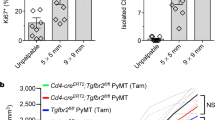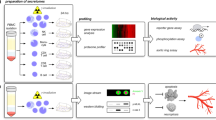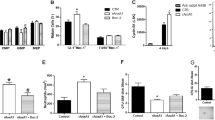Abstract
Bone-marrow-derived cells facilitate tumour angiogenesis, but the molecular mechanisms of this facilitation are incompletely understood. We have previously shown that the related EG-VEGF and Bv8 proteins, also known as prokineticin 1 (Prok1) and prokineticin 2 (Prok2), promote both tissue-specific angiogenesis and haematopoietic cell mobilization. Unlike EG-VEGF, Bv8 is expressed in the bone marrow. Here we show that implantation of tumour cells in mice resulted in upregulation of Bv8 in CD11b+Gr1+ myeloid cells. We identified granulocyte colony-stimulating factor as a major positive regulator of Bv8 expression. Anti-Bv8 antibodies reduced CD11b+Gr1+ cell mobilization elicited by granulocyte colony-stimulating factor. Adenoviral delivery of Bv8 into tumours was shown to promote angiogenesis. Anti-Bv8 antibodies inhibited growth of several tumours in mice and suppressed angiogenesis. Anti-Bv8 treatment also reduced CD11b+Gr1+ cells, both in peripheral blood and in tumours. The effects of anti-Bv8 antibodies were additive to those of anti-Vegf antibodies or cytotoxic chemotherapy. Thus, Bv8 modulates mobilization of CD11b+Gr1+ cells from the bone marrow during tumour development and also promotes angiogenesis locally.
This is a preview of subscription content, access via your institution
Access options
Subscribe to this journal
Receive 51 print issues and online access
$199.00 per year
only $3.90 per issue
Buy this article
- Purchase on Springer Link
- Instant access to full article PDF
Prices may be subject to local taxes which are calculated during checkout





Similar content being viewed by others
References
Ferrara, N. & Kerbel, R. S. Angiogenesis as a therapeutic target. Nature 438, 967–974 (2005)
Carmeliet, P. Angiogenesis in health and disease. Nature Med. 9, 653–660 (2003)
Ferrara, N., Gerber, H. P. & LeCouter, J. The biology of VEGF and its receptors. Nature Med. 9, 669–676 (2003)
Folkman, J. & Klagsbrun, M. Angiogenic factors. Science 235, 442–447 (1987)
Dong, J. et al. VEGF-null cells require PDGFR α signaling-mediated stromal fibroblast recruitment for tumorigenesis. EMBO J. 23, 2800–2810 (2004)
Orimo, A. et al. Stromal fibroblasts present in invasive human breast carcinomas promote tumor growth and angiogenesis through elevated SDF-1/CXCL12 secretion. Cell 121, 335–348 (2005)
Coussens, L. M. & Werb, Z. Inflammation and cancer. Nature 420, 860–867 (2002)
Rafii, S., Lyden, D., Benezra, R., Hattori, K. & Heissig, B. Vascular and haematopoietic stem cells: novel targets for anti-angiogenesis therapy? Nature Rev. Cancer 2, 826–835 (2002)
Nolan, D. J. et al. Bone marrow-derived endothelial progenitor cells are a major determinant of nascent tumor neovascularization. Genes Dev. 21, 1546–1558 (2007)
De Palma, M., Venneri, M. A., Roca, C. & Naldini, L. Targeting exogenous genes to tumor angiogenesis by transplantation of genetically modified hematopoietic stem cells. Nature Med. 9, 789–795 (2003)
Yang, L. et al. Expansion of myeloid immune suppressor Gr+CD11b+ cells in tumor-bearing host directly promotes tumor angiogenesis. Cancer Cell 6, 409–421 (2004)
De Palma, M. et al. Tie2 identifies a hematopoietic lineage of proangiogenic monocytes required for tumor vessel formation and a mesenchymal population of pericyte progenitors. Cancer Cell 8, 211–226 (2005)
Grunewald, M. et al. VEGF-induced adult neovascularization: recruitment, retention, and role of accessory cells. Cell 124, 175–189 (2006)
Shojaei, F. et al. Tumor refrectoriness to anti-VEGF treatment is mediated by CD11b+Gr1+ myeloid cells. Nature Biotechnol. 25, 911–920 (2007)
Nozawa, H., Chiu, C. & Hanahan, D. Infiltrating neutrophils mediate the initial angiogenic switch in a mouse model of multistage carcinogenesis. Proc. Natl Acad. Sci. USA 103, 12493–12498 (2006)
van Kempen, L. C., de Visser, K. E. & Coussens, L. M. Inflammation, proteases and cancer. Eur. J. Cancer 42, 728–734 (2006)
Bergers, G. et al. Matrix metalloproteinase-9 triggers the angiogenic switch during carcinogenesis. Nature Cell Biol. 2, 737–744 (2000)
Li, M., Bullock, C. M., Knauer, D. J., Ehlert, F. J. & Zhou, Q. Y. Identification of two prokineticin cDNAs: recombinant proteins potently contract gestrointestinal smooth muscle. Mol. Pharmacol. 59, 692–698 (2001)
LeCouter, J. et al. Identification of an angiogenic mitogen selective for endocrine gland endothelium. Nature 412, 877–884 (2001)
LeCouter, J. et al. The endocrine-gland-derived VEGF homologue Bv8 promotes angiogenesis in the testis: localization of Bv8 receptors to endothelial cells. Proc. Natl Acad. Sci. USA 100, 2685–2690 (2003)
Mollay, C. et al. Bv8, a small protein from frog skin and its homologue from snake venom induce hyperalgesia in rats. Eur. J. Pharmacol. 374, 189–196 (1999)
Masuda, Y. et al. Isolation and identification of EG-VEGF/prokineticins as cognate ligands for two orphan G-protein-coupled receptors. Biochem. Biophys. Res. Commun. 293, 396–402 (2002)
Lin, D. C. et al. Identification and molecular characterization of two closely related G protein-coupled receptors activated by prokineticins/endocrine gland vascular endothelial growth factor. J. Biol. Chem. 277, 19276–19280 (2002)
LeCouter, J., Lin, R. & Ferrara, N. Endocrine gland-derived VEGF and the emerging hypothesis of organ-specific regulation of angiogenesis. Nature Med. 8, 913–917 (2002)
LeCouter, J., Zlot, C., Tejada, M., Peale, F. & Ferrara, N. Bv8 and endocrine gland-derived vascular endothelial growth factor stimulate hematopoiesis and hematopoietic cell mobilization. Proc. Natl Acad. Sci. USA 101, 16813–16818 (2004)
Dorsch, M. et al. PK1/EG-VEGF induces monocyte differentiation and activation. J. Leukoc. Biol. 78, 426–434 (2005)
Dahl, R. et al. Regulation of macrophage and neutrophil cell fates by the PU.1:C/EBPα ratio and granulocyte colony-stimulating factor. Nature Immunol. 4, 1029–1036 (2003)
Lagasse, E. & Weissman, I. L. Flow cytometric identification of murine neutrophils and monocytes. J. Immunol. Methods 197, 139–150 (1996)
Metcalf, D. The molecular control of cell division, differentiation commitment and maturation in haemopoietic cells. Nature 339, 27–30 (1989)
Christopher, M. J. & Link, D. C. Regulation of neutrophil homeostasis. Curr. Opin. Hematol. 14, 3–8 (2007)
Mueller, M. M. & Fusenig, N. E. Tumor–stroma interactions directing phenotype and progression of epithelial skin tumor cells. Differentiation 70, 486–497 (2002)
Liang, W. C. et al. Cross-species VEGF-blocking antibodies completely inhibit the growth of human tumor xenografts and measure the contribution of stromal VEGF. J. Biol. Chem. 281, 951–961 (2006)
Okazaki, T. et al. Granulocyte colony-stimulating factor promotes tumor angiogenesis via increasing circulating endothelial progenitor cells and Gr1+CD11b+ cells in cancer animal models. Int. Immunol. 18, 1–9 (2006)
Garcia-Sanz, A., Rodriguez-Barbero, A., Bentley, M. D., Ritman, E. L. & Romero, J. C. Three-dimensional microcomputed tomography of renal vasculature in rats. Hypertension 31, 440–444 (1998)
Maehara, N. Experimental microcomputed tomography study of the 3D microangioarchitecture of tumors. Eur. Radiol. 13, 1559–1565 (2003)
Kwon, H. M. et al. Enhanced coronary vasa vasorum neovascularization in experimental hypercholesterolemia. J. Clin. Invest. 101, 1551–1556 (1998)
Neben, S., Marcus, K. & Mauch, P. Mobilization of hematopoietic stem and progenitor cell subpopulations from the marrow to the blood of mice following cyclophosphamide and/or granulocyte colony-stimulating factor. Blood 81, 1960–1967 (1993)
Kavgaci, H., Ozdemir, F., Aydin, F., Yavuz, A. & Yavuz, M. Endogenous granulocyte colony-stimulating factor (G-CSF) levels in chemotherapy-induced neutropenia and in neutropenia related with primary diseases. J. Exp. Clin. Cancer Res. 21, 475–479 (2002)
Cheng, M. Y. et al. Prokineticin 2 transmits the behavioural circadian rhythm of the suprachiasmatic nucleus. Nature 417, 405–410 (2002)
Matsumoto, S. et al. Abnormal development of the olfactory bulb and reproductive system in mice lacking prokineticin receptor PKR2. Proc. Natl Acad. Sci. USA 103, 4140–4145 (2006)
Ohki, Y. et al. Granulocyte colony-stimulating factor promotes neovascularization by releasing vascular endothelial growth factor from neutrophils. FASEB J. 19, 2005–2007 (2005)
Hirbe, A. C. et al. Granulocyte colony-stimulating factor enhances bone tumor growth in mice in an osteoclast-dependent manner. Blood 109, 3424–3431 (2007)
Eyles, J. L., Roberts, A. W., Metcalf, D. & Wicks, I. P. Granulocyte colony-stimulating factor and neutrophils—forgotten mediators of inflammatory disease. Nature Clin. Pract. Rheumatol. 2, 500–510 (2006)
Tomayko, M. M. & Reynolds, C. P. Determination of subcutaneous tumor size in athymic (nude) mice. Cancer Chemother. Pharmacol. 24, 148–154 (1989)
Hida, K. et al. Tumor-associated endothelial cells with cytogenetic abnormalities. Cancer Res. 64, 8249–8255 (2004)
Acknowledgements
We thank the Flow Cytometry Laboratory and the Animal Care Facility for their help. We express our appreciation to G. Fuh, A. Chuntarapai, K. Schroeder and the Antibody Technology group. We acknowledge S. Beddha for immunohistochemistry. We also thank J. LeCouter and M. Singh for reading the manuscript.
Author Contributions F.S., X.W. and C.Z. contributed equally to this work. F.S. and N.F. wrote the manuscript. F.S., X.W., C.Z., L.Y., X.-H.L., J.Y., D.B., C.B., F.V.P., N.v.B., C.H., J.R., M.T., R.A.D.C., Y.G.M and N.F. performed experiments, designed research and analysed data.
Author information
Authors and Affiliations
Corresponding author
Ethics declarations
Competing interests
The authors are employees and shareholders of Genentech Inc.
Supplementary information
Supplementary Information
The file contains Supplementary Notes and Supplementary Figures S1-S12 with Legends. (PDF 1281 kb)
Rights and permissions
About this article
Cite this article
Shojaei, F., Wu, X., Zhong, C. et al. Bv8 regulates myeloid-cell-dependent tumour angiogenesis. Nature 450, 825–831 (2007). https://doi.org/10.1038/nature06348
Received:
Accepted:
Issue Date:
DOI: https://doi.org/10.1038/nature06348
This article is cited by
-
Myeloid-derived suppressor cells in cancer and cancer therapy
Nature Reviews Clinical Oncology (2024)
-
Extramedullary hematopoiesis in cancer
Experimental & Molecular Medicine (2024)
-
The evolution and heterogeneity of neutrophils in cancers: origins, subsets, functions, orchestrations and clinical applications
Molecular Cancer (2023)
-
Biology and therapeutic targeting of vascular endothelial growth factor A
Nature Reviews Molecular Cell Biology (2023)
-
Vascular mimicry induced by m6A mediated IGFL2-AS1/AR axis contributes to pazopanib resistance in clear cell renal cell carcinoma
Cell Death Discovery (2023)
Comments
By submitting a comment you agree to abide by our Terms and Community Guidelines. If you find something abusive or that does not comply with our terms or guidelines please flag it as inappropriate.



